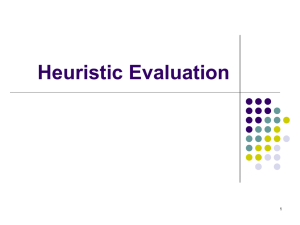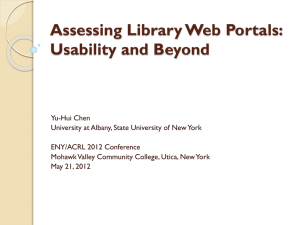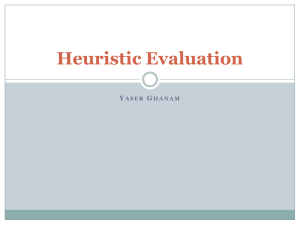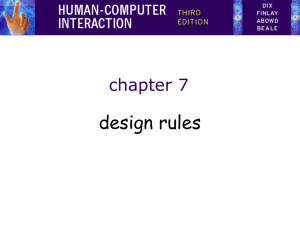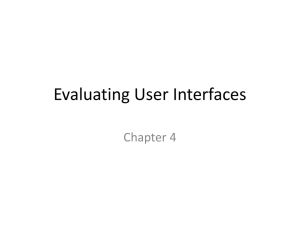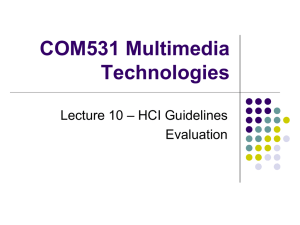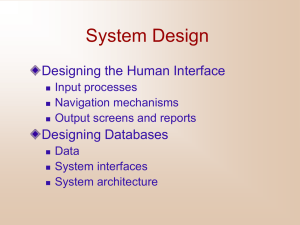Error prevention
advertisement
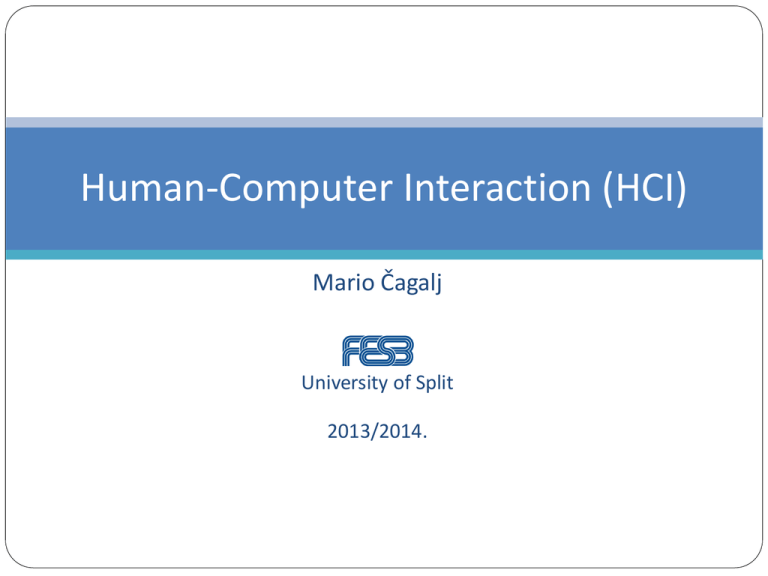
Human-Computer Interaction (HCI) Mario Čagalj University of Split 2013/2014. Design Heuristics and Heuristic Evaluation Based on slides by Saul Greenberg and Rob Miller’s “User Interface Design and Implementation”, MIT, 2006 Introduction Heuristic evaluation: what? an informal method of usability inspection usability specialists judge whether a user interface follows established usability principles Heuristic evaluation: why and how? to avoid common design pitfalls define some design principles (usability guidelines (‘heuristics’)) inspect an interface for usability problems with these principles 3 Iterative design process Heuristics are useful in two stages of the design process design: guide you in choosing between design alternatives evaluation: identifying problems in an implemented interface Design Task-centered design Human capabilities Fitts’ law Norman stages of action Mental models Design heuristics Evaluation Implementation Heuristic evaluation Prototyping 4 Usability guidelines (‘heuristics’) User-interface design guidelines are based on human psychology (‘Designing with the Mind in Mind’) There are plenty of sets of guidelines to choose from almost every researcher has their own set of heuristics most of these heuristics overlap, however the experts do not disagree about what constitutes a good UI they disagree about how to organize what we know into a small set of simple rules In this lecture, we will use Jakob Nielsen’s 10 heuristics “Heuristic evaluation of user interfaces” J. Nielsen and R. Molich SIGCHI conference on Human factors in computing systems (CHI’90) 5 Ten usability heuristics Match between system and the real world 1. The system should speak the users' language, with words, phrases and concepts familiar to the user, rather than system-oriented terms. Consistency and standards 2. Users should not have to wonder whether different words, situations, or actions mean the same thing. Follow platform conventions. 3. Visibility of system status The system should always keep users informed about what is going on, through appropriate feedback within reasonable time. User control and freedom 4. Users often choose system functions by mistake and will need a clearly marked "emergency exit" to leave the unwanted state without having to go through an extended dialogue. Support undo and redo. 6 Ten usability heuristics Error prevention 5. Even better than good error messages is a careful design which prevents a problem from occurring in the first place. Either eliminate error-prone conditions or check for them and present users with a confirmation option before they commit to the action. Help users recognize, diagnose, and recover from errors 6. Error messages should be expressed in plain language (no codes), precisely indicate the problem, and constructively suggest a solution Recognition rather than recall 7. Minimize the user's memory load by making objects, actions, and options visible. The user should not have to remember information from one part of the dialogue to another. Instructions for use of the system should be visible or easily retrievable whenever appropriate. 7 Ten usability heuristics Flexibility and efficiency of use 8. Accelerators -- unseen by the novice user -- may often speed up the interaction for the expert user such that the system can cater to both inexperienced and experienced users. Allow users to tailor frequent actions. Aesthetic and minimalist design 9. Dialogues should not contain information which is irrelevant or rarely needed. Every extra unit of information in a dialogue competes with the relevant units of information and diminishes their relative visibility. 10. Help and documentation Even though it is better if the system can be used without documentation, it may be necessary to provide help and documentation. Any such information should be easy to search, focused on the user's task, list concrete steps to be carried out, and not be too large. 8 Ten usability heuristics Match between system and the real world 1. The system should speak the users' language, with words, phrases and concepts familiar to the user, rather than system-oriented terms. Consistency and standards 2. Users should not have to wonder whether different words, situations, or actions mean the same thing. Follow platform conventions. 3. Visibility of system status The system should always keep users informed about what is going on, through appropriate feedback within reasonable time. User control and freedom 4. Users often choose system functions by mistake and will need a clearly marked "emergency exit" to leave the unwanted state without having to go through an extended dialogue. Support undo and redo. 9 H1: Match system and real world (speak the user’s language) Use common words, not techie jargon but use domain-specific terms where appropriate Q: What the user does in this example? Don’t put limits on user defined names old DOS problems (8 char name + 3 char extensions) Allow aliases/synonyms in command languages Use metaphors, but be careful they but may mislead trashcan desktop 10 H1: Speak the users’ language My program gave me the message Rstrd Info. What does it mean? Hmm… but what does it mean??? That’s restricted information It means the program is too busy to let you log on But surely you can tell me!!! No, no… Rsdrd Info stands for “Restricted Information” Ok, I’ll take a coffee H1: Speak the users’ language Terminology based on users’ language for task e.g. withdrawing money from a bank machine 12 Ten usability heuristics Match between system and the real world 1. The system should speak the users' language, with words, phrases and concepts familiar to the user, rather than system-oriented terms. Consistency and standards 2. Users should not have to wonder whether different words, situations, or actions mean the same thing. Follow platform conventions. 3. Visibility of system status The system should always keep users informed about what is going on, through appropriate feedback within reasonable time. User control and freedom 4. Users often choose system functions by mistake and will need a clearly marked "emergency exit" to leave the unwanted state without having to go through an extended dialogue. Support undo and redo. 13 H2: Consistency and standards Principle of Least Surprise similar things should look and act similar different things should look different users should not have to wonder whether different words, situations, or actions mean the same thing (follow platform conventions) Consistent language and graphics same visual appearance across the system same information/controls in same location on all windows Consistent effects commands, actions have same effect in equivalent situations 14 H2: Consistency and standards These are labels with a raised appearance. Is it any surprise that people try and click on them? Consistency is in wording 15 H2: Kinds of consistency to worry about Internal within your application External with other applications Metaphorical with your interface metaphor or similar real-world objects 16 H2: Case Against Consistency Inconsistency is appropriate when context and task demand it arrow keys But if all else is (almost) equal, consistency wins QWERTY vs. Dvorak OK/Cancel button order Ten usability heuristics Match between system and the real world 1. The system should speak the users' language, with words, phrases and concepts familiar to the user, rather than system-oriented terms. Consistency and standards 2. Users should not have to wonder whether different words, situations, or actions mean the same thing. Follow platform conventions. 3. Visibility of system status The system should always keep users informed about what is going on, through appropriate feedback within reasonable time. User control and freedom 4. Users often choose system functions by mistake and will need a clearly marked "emergency exit" to leave the unwanted state without having to go through an extended dialogue. Support undo and redo. 18 H3: Visibility of system status (feedback) Keep user informed of system state Cursor change Selection highlight Status bar Don’t overdo it… Response time < 0.1 s: seems instantaneous 0.1-1 s: user notices, but no feedback needed 1-5 s: display busy cursor > 1-5 s: display progress bar 19 H3: Visibility of system status (feedback) Shoulder surfing protection (bad) Lotus Notes (good) Feedback through a set of hieroglyphics derived from what you typed in 20 Ten usability heuristics Match between system and the real world 1. The system should speak the users' language, with words, phrases and concepts familiar to the user, rather than system-oriented terms. Consistency and standards 2. Users should not have to wonder whether different words, situations, or actions mean the same thing. Follow platform conventions. 3. Visibility of system status The system should always keep users informed about what is going on, through appropriate feedback within reasonable time. User control and freedom 4. Users often choose system functions by mistake and will need a clearly marked "emergency exit" to leave the unwanted state without having to go through an extended dialogue. Support undo and redo. 21 H4: User control and freedom Provide clearly marked exits Users don’t like to feel trapped by the computer! should offer an easy way out of as many situations as possible Strategies: Cancel button (for dialogs waiting for user input) Universal Undo (can get back to previous state) Interrupt (especially for lengthy operations) Quit (for leaving the program at any time) Defaults (for restoring a property sheet) Core Dump H4: User control and freedom All dialogs should have a cancel button 23 Ten usability heuristics Error prevention 5. Even better than good error messages is a careful design which prevents a problem from occurring in the first place. Either eliminate error-prone conditions or check for them and present users with a confirmation option before they commit to the action. Help users recognize, diagnose, and recover from errors 6. Error messages should be expressed in plain language (no codes), precisely indicate the problem, and constructively suggest a solution Recognition rather than recall 7. Minimize the user's memory load by making objects, actions, and options visible. The user should not have to remember information from one part of the dialogue to another. Instructions for use of the system should be visible or easily retrievable whenever appropriate. 24 H5: Error prevention Selection is less error-prone than typing But don’t go overboard… Disable illegal commands Keep dangerous commands away from common ones 25 H5: Error prevention People will make errors! Errors we make Mistakes conscious deliberations lead to an error instead of correct solution Slips unconscious behaviour gets misdirected en route to satisfying goal e.g. drive to store, end up in the office shows up frequently in skilled behaviour usually due to inattention often arises from similar actions H5: Error prevention Designing for slips General rules prevent slips before they occur detect and correct slips when they do occur user correction through feedback and undo 27 H5: Error prevention Types of slips Capture error frequently done activity takes charge instead of one intended occurs when common & rarer actions have same initial sequence change clothes for dinner and find oneself in bed (William James, 1890) confirm saving of a file when you don’t want to delete it minimize by make actions undoable instead of confirmation allows reconsideration of action by user e.g. open trash to undelete a file I can’t believe I pressed Yes... H5: Error prevention Types of slips Description error intended action similar to others that are possible usually occurs when right & wrong objects physically near each other pour juice into bowl instead of glass throw sweaty shirt in toilet instead of laundry basket move file to wrong folder with similar name minimize by rich feedback check for reasonable input, etc. undo 29 H5: Error prevention Types of slips Mode errors people do actions in one mode thinking they are in another refer to file that’s in a different directory look for commands / menu options that are not relevant minimize by have as few modes as possible (preferably none) make modes highly visible Caps Lock inidicator (does it work?) 30 H5: Error prevention Types of slips Mode error example (MIT Webmail) Alt + D: deletes mails, puts keyboard focus on the address bar, invokes Denylist depending on the mouse focus 31 Ten usability heuristics Error prevention 5. Even better than good error messages is a careful design which prevents a problem from occurring in the first place. Either eliminate error-prone conditions or check for them and present users with a confirmation option before they commit to the action. Help users recognize, diagnose, and recover from errors 6. Error messages should be expressed in plain language (no codes), precisely indicate the problem, and constructively suggest a solution Recognition rather than recall 7. Minimize the user's memory load by making objects, actions, and options visible. The user should not have to remember information from one part of the dialogue to another. Instructions for use of the system should be visible or easily retrievable whenever appropriate. 32 H6: Help users recognize, diagnose, and recover from errors What is “error 15762”? H6: Help users recognize, diagnose, and recover from errors A problematic message to a nuclear power plant operator H6: Help users recover from errors Deal with errors in a positive manner Adobe's ImageReady AutoCAD Mechanical Windows Notepad Microsoft's NT Operating System H6: Help users recognize, diagnose, and recover from errors Be precise; restate user’s input not “Cannot open file”, but “Cannot open file named paper.doc” Give constructive help why error occurred and how to fix it Be polite and nonblaming Not “fatal error”, not “illegal” Hide technical details (stack trace) until requested 36 Ten usability heuristics Error prevention 5. Even better than good error messages is a careful design which prevents a problem from occurring in the first place. Either eliminate error-prone conditions or check for them and present users with a confirmation option before they commit to the action. Help users recognize, diagnose, and recover from errors 6. Error messages should be expressed in plain language (no codes), precisely indicate the problem, and constructively suggest a solution Recognition rather than recall 7. Minimize the user's memory load by making objects, actions, and options visible. The user should not have to remember information from one part of the dialogue to another. Instructions for use of the system should be visible or easily retrievable whenever appropriate. 37 H7: Recognition rather than recall H7: Recognition rather than recall Use menus, not command languages Use combo boxes, not textboxes Use generic commands where possible (Open, Save, Copy Paste) All needed information should be visible 39 Ten usability heuristics Flexibility and efficiency of use 8. Accelerators -- unseen by the novice user -- may often speed up the interaction for the expert user such that the system can cater to both inexperienced and experienced users. Allow users to tailor frequent actions. Aesthetic and minimalist design 9. Dialogues should not contain information which is irrelevant or rarely needed. Every extra unit of information in a dialogue competes with the relevant units of information and diminishes their relative visibility. 10. Help and documentation Even though it is better if the system can be used without documentation, it may be necessary to provide help and documentation. Any such information should be easy to search, focused on the user's task, list concrete steps to be carried out, and not be too large. 40 H8: Flexibility and efficiency of use (shorcuts) Provide easily-learned shortcuts for frequent operations Keyboard accelerators Command abbreviations Styles Bookmarks History 41 Ten usability heuristics Flexibility and efficiency of use 8. Accelerators -- unseen by the novice user -- may often speed up the interaction for the expert user such that the system can cater to both inexperienced and experienced users. Allow users to tailor frequent actions. Aesthetic and minimalist design 9. Dialogues should not contain information which is irrelevant or rarely needed. Every extra unit of information in a dialogue competes with the relevant units of information and diminishes their relative visibility. 10. Help and documentation Even though it is better if the system can be used without documentation, it may be necessary to provide help and documentation. Any such information should be easy to search, focused on the user's task, list concrete steps to be carried out, and not be too large. 42 H9: Aesthetic and minimalist design “Less is More” Omit extraneous info, graphics, features 43 H9: Aesthetic and minimalist design Good graphic design Few, well-chosen colors and fonts Group with whitespace Align controls sensibly Use concise language Choose labels carefully 44 Ten usability heuristics Flexibility and efficiency of use 8. Accelerators -- unseen by the novice user -- may often speed up the interaction for the expert user such that the system can cater to both inexperienced and experienced users. Allow users to tailor frequent actions. Aesthetic and minimalist design 9. Dialogues should not contain information which is irrelevant or rarely needed. Every extra unit of information in a dialogue competes with the relevant units of information and diminishes their relative visibility. 10. Help and documentation Even though it is better if the system can be used without documentation, it may be necessary to provide help and documentation. Any such information should be easy to search, focused on the user's task, list concrete steps to be carried out, and not be too large. 45 H10: Provide documentation and help Users don’t read manuals Prefer to spend time working toward their task goals, not learning about your system But manuals and online help are vital Usually when user is frustrated or in crisis Help should be: Searchable Context-sensitive Task-oriented Don’t forget: Help is not a replacement for bad design! Concrete Short E.g., Microsoft is exclusively task-oriented impossible to get a high-level overview 46 Heuristic Evaluation Problems found by a single inspector Average over six case studies 35% of all usability problems; 42% of the major problems 32% of the minor problems Not great, but finding some problems with one evaluator is much better than finding no problems with no evaluators! Problems found by a single inspector Varies according to difficulty of the interface being evaluated the expertise of the inspectors Average problems found by: novice evaluators - 22% no usability expertise regular specialists - 41% expertise in usability double specialists - 60% experience in both usability and the particular kind of interface being evaluated also find domain-related problems Tradeoff novices poorer, but cheaper! 49 Problems found by a single inspector Evaluators miss both easy and hard problems ‘best’ evaluators can miss easy problems ‘worse’ evaluators can discover hard problems 50 Problems found by multiple evaluators 3-5 evaluators find 66-75% of usability problems different people find different usability problems only modest overlap between the sets of problems found 51 Problems found by multiple evaluators Where is the best cost/benefit? 52 Individuals vs teams Nielsen recommends individual evaluators inspect the interface alone Why? evaluation is not influenced by others independent and unbiased greater variability in the kinds of errors found no overhead required to organize group meetings Self Guided vs Scenario Exploration Self-guided open-ended exploration Not necessarily task-directed good for exploring diverse aspects of the interface, and to follow potential pitfalls Scenarios step through the interface using representative end user tasks ensures problems identified in relevant portions of the interface ensures that specific features of interest are evaluated but limits the scope of the evaluation - problems can be missed
